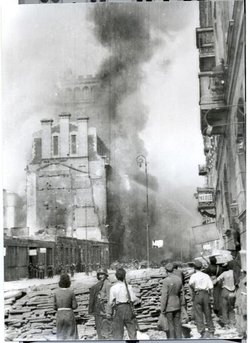Flamethrower
|
|
A flamethrower is a mechanical device designed to throw flames or, more correctly, project an ignited stream of liquid. It is used by the military and also by those needing controlled burning, such as in agriculture or other land management tasks.
| Contents |
Military flamethrowers
The man-portable incendiary weapon is usually called a backpack flamethrower. The backpack element consists of two or three cylinders. One cylinder holds flammable liquid and the other compressed flammable gas. A three cylinder system has two outer cylinders of liquid and a central cylinder of gas to improve the balance. The gas is used to force the liquid out of the cylinder into a pipe and then the gun part of the system. The gun attachment consists of a small reservoir, a spring valve and an ignition system; depressing a trigger opens the valve and allows the pressurized liquid to pass over the ignitor and out of the weapon. The ignitor can be one of a number of systems, a simple type is a wire coil which is heated electrically. A more complex, more reliable system has a small flame fuelled by the pressurized gas from the system.
It is a weapon with a potent impact on unprepared troops, delivering a particularly unpleasant death; it can have great psychological impact. It is primarily deployed against battlefield fortifications. A flamethrower projects liquid rather than flame so the flaming liquid jet can be 'bounced' off walls or ceilings to project the fire into unseen spaces such as the interior of bunkers or pillboxes. Also an unignited stream can be fired and then subsequently ignited.
History
Warsaw_Uprising_flamethrower.JPG
The first flamethrower, in the modern sense, is usually credited to the German Richard Fiedler. He submitted evaluation models of his Flammenwerfer to the German army in 1901. The most significant model he submitted was a man portable device, consisting of a single cylinder around 4 feet (1.2 m) high, divided horizontally with a pressurized gas lower section and inflammable oil in the top section. On depressing a lever the gas forced the liquid through a rubber tube and over a simple wick igniting device in a steel nozzle. The weapon could project a flaming jet and enormous clouds of smoke around 20 yards (18 m) with two minutes of firing time. It was a single shot device - for burst firing a new ignitor section had to be attached each time.
It was not until 1911 that the German army accepted the device, creating a specialist regiment of twelve companies equipped with Flammenwerferapparate. Despite this the weapon was not used in WW I until February 1916 when it was briefly used against the French at Verdun. It was not used again until July 1916 when it was used against British trenches at Hooge, where it had limited but impressive success.
Warsaw_Uprising_flamethrower2.JPG
It was discovered that the weapon had certain drawbacks: it was cumbersome and difficult to operate and could only be fired safely from a trench, so limiting its safe use to areas where the opposing trenches were less than 20 yards apart, not a common event. Flamethrower operators were exceedingly vulnerable, and they were very rarely taken prisoner, especially when their targets survived the impact of the weapon. The British and French tested flamethrower systems but soon abandoned them. The German army continued to deploy them throughout the war and they were used on over 300 occasions, usually in teams of six flamethrowers.

Flamethrowers were used extensively in World War II. The vulnerability of operators on foot, coupled with the weapon's short range, caused experiments with tank mounted units (called flame tanks). The British hardly developed man-portable systems, but the US Marines found them especially useful in clearing Japanese trench and bunker complexes in the Pacific. In cases where the Japanese were entrenched in deep caves, the flames could not reach them but consumed the oxygen and the Japanese suffocated. The Marines eventually stopped using their M2-2 with the arrival of adapted Sherman tanks with the Ronson system. The Germans made considerable use of the weapon during the invasion of western Europe but it soon fell out of favour except for use in reprisal operations. However, on the Eastern Front its use both on the battlefield and for "scorched earth" tactics continued until the end of the war.
There is a picture and a short description of the M2A1-7 USA army flamethrower.
The US Marines took the weapon on to the Korean War and Vietnam.
The British WWII army flamethrowers, 'Ack Pack', had a doughnut-shaped fuel tank with a small spherical pressurizer gas tank in the middle. As a result, some troops nicknamed them "lifebuoys". WWII German army flamethrowers tended to have one big fueltank with the pressurizer tank fastened to its back or side. Some WWII German army flamethrowers occupied only the lower part of its wearer's back, leaving the upper part of his back free for an ordinary packful of supplies. Some Russian army flamethrowers had three backpack tanks side by side. Some descriptions seem to say that its user could fire three shots, each emptying one of the tanks.
Flamethrowers in movies are more likely to use inflammable pressurized gas (such as propane) only, producing a flaming effect but with none of the spray, splatter, smoke and area effect of the genuine weapon.
Private ownership
Private ownership of flamethrowers is not restricted in the United States. Some collectors of military hardware claim to use them to clear the ice off their driveway in the winter. Flamethrowers are also sometimes used for igniting controlled burns of grassland or forest, although more commonly a driptorch or a flare (fusee) is used.
See also
External links
- First World War.com: Weapons of War: Flamethrowers (http://www.firstworldwar.com/weaponry/flamethrowers.htm)
- Howstuffworks "How Flamethrowers Work" (http://science.howstuffworks.com/flamethrower.htm)

